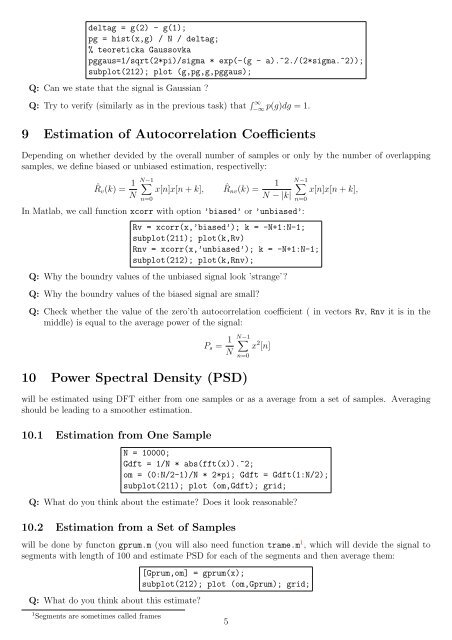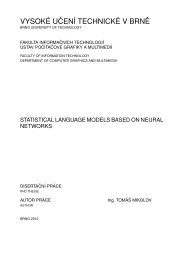Random Processes – Fundamentals 1 Generation of a Random ...
Random Processes – Fundamentals 1 Generation of a Random ...
Random Processes – Fundamentals 1 Generation of a Random ...
You also want an ePaper? Increase the reach of your titles
YUMPU automatically turns print PDFs into web optimized ePapers that Google loves.
deltag = g(2) - g(1);<br />
pg = hist(x,g) / N / deltag;<br />
% teoreticka Gaussovka<br />
pggaus=1/sqrt(2*pi)/sigma * exp(-(g - a).^2./(2*sigma.^2));<br />
subplot(212); plot (g,pg,g,pggaus);<br />
Q: Can we state that the signal is Gaussian ?<br />
Q: Try to verify (similarly as in the previous task) that � ∞<br />
−∞ p(g)dg = 1.<br />
9 Estimation <strong>of</strong> Autocorrelation Coefficients<br />
Depending on whether devided by the overall number <strong>of</strong> samples or only by the number <strong>of</strong> overlapping<br />
samples, we define biased or unbiased estimation, respectivelly:<br />
ˆRv(k) = 1<br />
N−1 �<br />
x[n]x[n + k],<br />
N<br />
n=0<br />
ˆ Rnv(k) =<br />
In Matlab, we call function xcorr with option ’biased’ or ’unbiased’:<br />
N−1<br />
1 �<br />
x[n]x[n + k],<br />
N − |k|<br />
n=0<br />
Rv = xcorr(x,’biased’); k = -N+1:N-1;<br />
subplot(211); plot(k,Rv)<br />
Rnv = xcorr(x,’unbiased’); k = -N+1:N-1;<br />
subplot(212); plot(k,Rnv);<br />
Q: Why the boundry values <strong>of</strong> the unbiased signal look ’strange’?<br />
Q: Why the boundry values <strong>of</strong> the biased signal are small?<br />
Q: Check whether the value <strong>of</strong> the zero’th autocorrelation coefficient ( in vectors Rv, Rnv it is in the<br />
middle) is equal to the average power <strong>of</strong> the signal:<br />
Ps = 1<br />
N−1 �<br />
x<br />
N<br />
2 [n]<br />
10 Power Spectral Density (PSD)<br />
will be estimated using DFT either from one samples or as a average from a set <strong>of</strong> samples. Averaging<br />
should be leading to a smoother estimation.<br />
10.1 Estimation from One Sample<br />
n=0<br />
N = 10000;<br />
Gdft = 1/N * abs(fft(x)).^2;<br />
om = (0:N/2-1)/N * 2*pi; Gdft = Gdft(1:N/2);<br />
subplot(211); plot (om,Gdft); grid;<br />
Q: What do you think about the estimate? Does it look reasonable?<br />
10.2 Estimation from a Set <strong>of</strong> Samples<br />
will be done by functon gprum.m (you will also need function trame.m 1 , which will devide the signal to<br />
segments with length <strong>of</strong> 100 and estimate PSD for each <strong>of</strong> the segments and then average them:<br />
Q: What do you think about this estimate?<br />
1 Segments are sometimes called frames<br />
[Gprum,om] = gprum(x);<br />
subplot(212); plot (om,Gprum); grid;<br />
5







